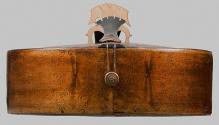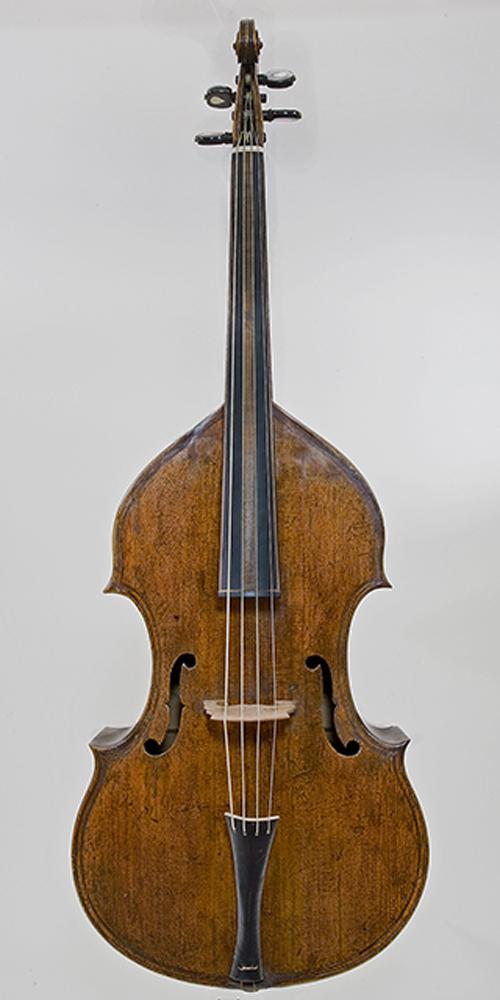Home
>
Works
>
Bass viola da gamba
>
Advanced Search
Bowed Strings
Violoncellos
Bass viola da gamba
Alternate name:Bass viol
Alternate name:Cello
Alternate name:Violoncello
Date: 1520-1564 ca.
Place Made:Brescia, Italy, Europe
Serial No: none
SignedWritten in black ink on paper label, the year written later in a lighter black ink: Zanetto da brescia / 1459
DescriptionThis Brescian viola da gamba may be one of the oldest stringed instruments at the NMM. It was converted to a small cello in the late eighteenth or early nineteenth century as musical tastes changed.
Top: two-piece, quarter-cut spruce: medium grain broadening to wide at the edges; the upper outline has been altered to be steeply sloped with added wood at joint wth neck
Back: one-piece, slab-cut maple: plain with some bird's eye and butt figure; back above break later; numerous wood pins along lower edge to repair separation due to shrinkage
Ribs: quarter-cut maple: plain; portions next to neck with additional later wood
Head: maple: plain; volutes do not protrude; later
Neck: maple: plain; grafted; additional wood added to sides to fit wider fingerboard; later
Arching: minimal recurve on top; flat back with break
Purfling: double on front; none on back
Varnish: medium brown
Fingerboard: black-stained light hardwood with ebony and maple veneer strips; center of underside has carved ridge with triangular outline; relatively flat curve; late 18th or early 19th century
Nut: bone with wood shim underneath; later
Tailpiece: black-stained maple; tailgut passes through holes drilled in face; slight ridge along center in lower half; late 18th or early 19th century
Tailgut: doubled copper wire
Pegs: four ebony with bone teardrops inlaid on faces and bone pins; slightly undercut; late 18th or early 19th century
Saddle: ebony; later
Endpin: boxwood with decoratively turned head; later
F-holes: wings come to points; strongly curved notches; deeply undercut
Linings: maple
Corner blocks: spruce; small
Top block: spruce; grain runs parallel to top and back; later
Bottom block: light hardwood; trapezoidal profile
Back braces: three, short spruce braces; one later, narrower brace at break
Other: saw marks on inside of ribs; toothed plane marks on back braces
Bridge: no heart; thin; decoratively cut lower profile; probably late 18th or early 19th century
Top: two-piece, quarter-cut spruce: medium grain broadening to wide at the edges; the upper outline has been altered to be steeply sloped with added wood at joint wth neck
Back: one-piece, slab-cut maple: plain with some bird's eye and butt figure; back above break later; numerous wood pins along lower edge to repair separation due to shrinkage
Ribs: quarter-cut maple: plain; portions next to neck with additional later wood
Head: maple: plain; volutes do not protrude; later
Neck: maple: plain; grafted; additional wood added to sides to fit wider fingerboard; later
Arching: minimal recurve on top; flat back with break
Purfling: double on front; none on back
Varnish: medium brown
Fingerboard: black-stained light hardwood with ebony and maple veneer strips; center of underside has carved ridge with triangular outline; relatively flat curve; late 18th or early 19th century
Nut: bone with wood shim underneath; later
Tailpiece: black-stained maple; tailgut passes through holes drilled in face; slight ridge along center in lower half; late 18th or early 19th century
Tailgut: doubled copper wire
Pegs: four ebony with bone teardrops inlaid on faces and bone pins; slightly undercut; late 18th or early 19th century
Saddle: ebony; later
Endpin: boxwood with decoratively turned head; later
F-holes: wings come to points; strongly curved notches; deeply undercut
Linings: maple
Corner blocks: spruce; small
Top block: spruce; grain runs parallel to top and back; later
Bottom block: light hardwood; trapezoidal profile
Back braces: three, short spruce braces; one later, narrower brace at break
Other: saw marks on inside of ribs; toothed plane marks on back braces
Bridge: no heart; thin; decoratively cut lower profile; probably late 18th or early 19th century
DimensionsLength of body: 63.5 cm
Depth of ribs: 11.5 cm
width of upper bouts: 29.5 cm
width of lower bouts: 32.7 cm
Vibrating string length: 59 cm
See also measurements by Ray Nurse
Total bass viola da gamba length: 1014 mm
Back length: 624 mm to end of button; 604 mm to upper rib
Upper bout width: 280 mm
Center bout width: 205 mm
Lower bout width: 368 mm
Upper rib height: 75-112 mm
Center rib height: 111-112 mm
Lower rib height: 107-112 mm
Stop length: 119 mm
Vibrating string length: mm
Neck length (bottom of nut to ribs): 262 mm
Depth of ribs: 11.5 cm
width of upper bouts: 29.5 cm
width of lower bouts: 32.7 cm
Vibrating string length: 59 cm
See also measurements by Ray Nurse
Total bass viola da gamba length: 1014 mm
Back length: 624 mm to end of button; 604 mm to upper rib
Upper bout width: 280 mm
Center bout width: 205 mm
Lower bout width: 368 mm
Upper rib height: 75-112 mm
Center rib height: 111-112 mm
Lower rib height: 107-112 mm
Stop length: 119 mm
Vibrating string length: mm
Neck length (bottom of nut to ribs): 262 mm
ProvenanceAccording to Leandro Bisiach, Jr., with whom Witten negotiated the purchase of seven viols in 1968-69, two of the instruments – the Linarol, Venice, 1582, and the Zanetto, Brescia, before 1564 – were among four instruments acquired by his father in the late 19th century from the Correr collections in Venice, most of which were sold in the 19th century to the Brussels and Vienna museums. Purchased by Laurence Witten from Giacomo and Leandro Bisiach, Venegono Superiore, Italy,1968.
Purchased by the National Music Museum from Laurence Witten family, New Haven, Connecticut, 1984.
Purchased by the National Music Museum from Laurence Witten family, New Haven, Connecticut, 1984.
Terms
Credit Line: Witten-Rawlins Collection, 1984
Not on view
Published ReferencesMargaret Downie Banks, “North Italian Viols at the Shrine to Music Museum,” Journal of the Viola da Gamba Society of America, Vol. XXI 1984), pp. 14-15 with photo p. 15.
Laurence Witten, II, “Apollo, Orpheus, and David,” Journal of the American Musical Instrument Society, Vol. 1 (1975), pp. 51-52.
A. M. Mucchi, Gasparo da Salo, (Milan: Ulrico Hoepli, 1978), p. 161.
Laurence Witten, “The Surviving Instruments of Andrea Amati,” Early Music, Vol. 10,
No. 4 (October 1982), p. 487.
Brend Neece, “The Cello in Britain: A Technical and Social History,” The Galpin
Society Journal, No. LVI (2003), pp. 101-102.
Laurence Witten, II, “Apollo, Orpheus, and David,” Journal of the American Musical Instrument Society, Vol. 1 (1975), pp. 51-52.
A. M. Mucchi, Gasparo da Salo, (Milan: Ulrico Hoepli, 1978), p. 161.
Laurence Witten, “The Surviving Instruments of Andrea Amati,” Early Music, Vol. 10,
No. 4 (October 1982), p. 487.
Brend Neece, “The Cello in Britain: A Technical and Social History,” The Galpin
Society Journal, No. LVI (2003), pp. 101-102.
Object number: 03376





























